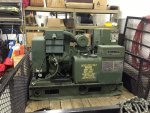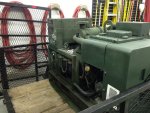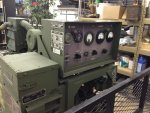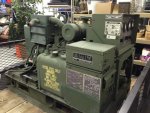I plan to preview an MEP-002A in the next few days and am curious what I should be looking for. I recognize there are lots of potential issues but I'm looking for a sense of what someone experienced in buying 002s would look for at a preview. I'll be previewing five or so 002s with hours ranging from 6 to 600. Thanks for any input.
First thing I'll say is that even being on site has it's limitations--there's only so much you're allowed to do when inspecting...but a few ideas I'll throw out:
1. If allowed, bring in a 1/2" breaker bar with (I think) a 5/8" socket and a small flat screwdriver. Use the screwdriver to carefully remove the plastic cap in the center of the shroud to access the blower wheel bolt hex. Use the breaker & socket to rotate the engine to confirm it's not seized up. Reinstall the plastic cap when done.
2. Look for obvious missing parts--gauges, meters, aux fuel pipes, ground rods, starters, battery hold-down frames, battery wires, switches, panel lights--to name as many as I could think of & most of the items that I've found missing. In cases where major components have been removed--this MAY indicate a damaged unit that has been subjected to the cannibals or maybe not...regardless, replacement parts are expensive, so consider this in your eagerness to buy...
3. Open fuel tank and look into tank--the interior tank condition can sometimes tell you the environment & care (or lack of) the unit was subjected to...
4. Look for oil leaks underneath the engine at both ends.
5. Inspect all wiring inside boxes and external--as best as you can access. Missing components or wiring--big red flag.
6. Inspect the generator head for any evidence of burning. Rust on top of the head may be a result of something burned, but normally it just means the paint failed due to poor surface prep or excessive heat from the normal operation of the generator. But black soot, burned smells--red flag.
7. Pull dipstick--it should be clean. If you see rust and/or evidence of water--red flag.
8. Try turning the phase selector switch (under the hinged plate). If it's stuck on a 3-phase setting, red flag..unless you want to attempt a disassemble, cleaning & light lube application--there's a post on here somewhere where someone successfully restored the function of this switch, though with great effort & time....If it's stuck in the 1-phase position & that's what you need, carry on.
9. If the unit is on a slab or other flat surface, look for any warping in the skid frame from forklift damage or dropping during rough ground handling or airlifts. If noticeable, a warped frame (skid) can cause abnormal loading on the bearings in the generator and/or the engine. Red flag if you see parts of the frame in contact with the surface and others raised in a noticeable racking condition.
10. Bashed in sheet metal on the housing, fuel tank or gauge/meter box may not affect function but they do serve to indicate some rough handling occurred.
11. The data plates, wiring schematic plates & the face of the meter/gauge board often provide indications if the unit was outside for extended periods. Faded, scratched or damaged plates also indicate prior operating conditions and long exposure to sun/heat/rain, etc.
12. There's been a few discussions about units painted in desert tan, vice OD green. It seems the tan units MAY have been in desert operations and have possibly experienced some harsh environmental conditions such as high temps and blowing sand/dust. In some cases I avoid these units but that's a personal preference. Interestingly I've also seen ODG units with evidence of DT paint underneath and vice-versa...
13. As to hour meters, the value on the meter may or may not represent the actual time on the machine. These are routinely swapped out to replace defective meters and the replacement meter may be new or a take-off from a donor machine. Log books for each machine are simply marked accordingly for planning future service intervals. Overall appearance of a unit means more to me than a hour meter reading, though I do put some weight to the meter reading.
14. Look closely at all of the fuel hoses. These are essentially double-braided & jacketed hydraulic hoses that are quite expensive to replace. If you see fuel seepage through the hose or obvious cracking or dry rotting, figure on about $10 per foot if you reuse your fittings and lots of elbow grease if you redo the fittings yourself....With new fittings--add about $30 per hose.
15. This one seems to be obvious but a few victims have been known to purchase 400 hz units, assuming the units are 60 hz. Always verify you're looking at a 60 hz unit.
Finally as a general comment about looking at photos vice what you see in person, I have recently noticed some significant variances between published photo sets vice on-site reality. For those not doing on-site previews, beware, beware, beware....The further a photo is taken away, the blurrier a photo set, the other-than-straight-on perspective of a photo and lastly--the low quantity of photos provided--all these can serve as a warning to be wary of what you think you're getting.
I'm sure there are many other areas & items to look at but these are some that came to mind. We could probably all write a four-page tech bulletin but this covers several to consider. I'm confident I missed a few, but it was not intentional & others can add to the list...
Good luck with your search.





